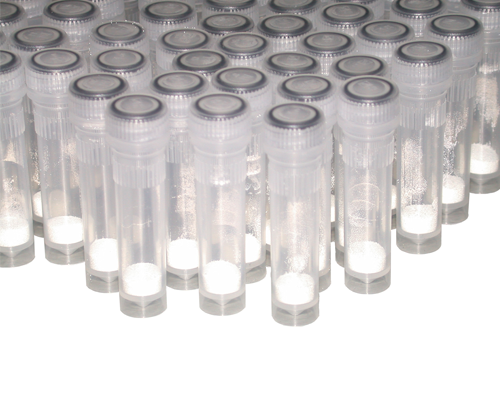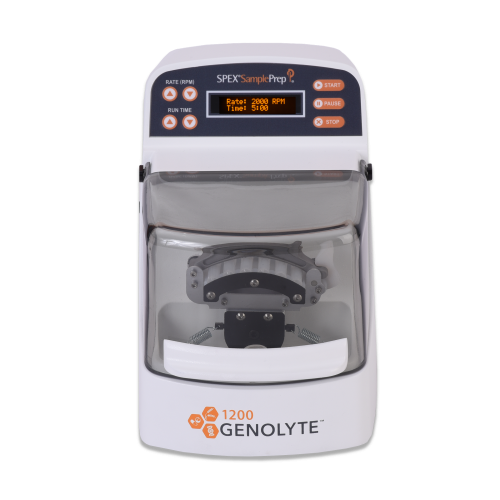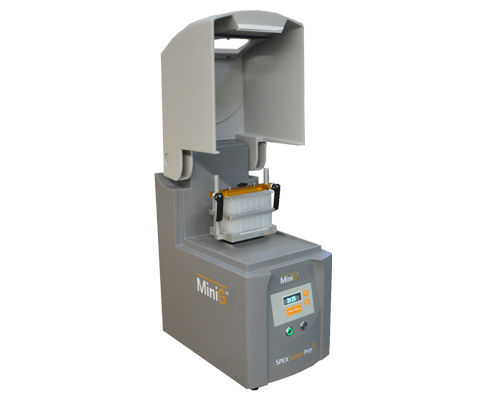-
 Microcentrifuge tubes filled with beads or small balls are widely used to bead beat microorganisms and small tissue samples. These disruption tubes are manufactured by OPS Diagnostics as a ready-to-use product and are available in multiple configurations. Using OPS Diagnostics’ acid washed, low binding, and molecular biology grade grinding beads, disruption tubes with measured amounts of grinding media minimize preparation by researchers. Several mixed mode configurations use different bead sizes in order to homogenize the sample at different levels, i.e., large beads to disrupt tissue and smaller beads to break open bacteria within a sample. The three categories of disruption tubes are as follows: Acid Washed Pre-Filled Tubes Like those sold in bulk, these beads have been washed with acid to remove detrimental contaminants that are found in raw beads. Zirconium beads are offered in the following diameters: 100 µm, 200 µm, 400 µm, 800 µm, 1.0 mm, 1.4 mm, 1.7 mm or 3.0 mm. Acid washed zirconium beads with both 800 µm and 1.4 mm diameters are also for sale. Disruption tubes with acid washed silica beads can be purchased in 100 µm, 400 µm, or 800 µm diameters. Additionally, OPS Diagnostics offers mixed media tubes with more than one type of grinding media, available with the following specifications. We have a disruption tube with 500 µm garnet and a 6 mm zirconium satellite as well as a disruption tube with 100 µm silica, 1.4 mm Zr and a 4 mm silica bead. Lastly, there is a disruption tube with 2.8 mm acid washed stainless steel grinding balls. The grinding media in these pre-filled tubes have been washed with diluted acid to remove potentially detrimental contaminants. Molecular Biology Grade Pre-Filled Tubes The grinding media in these tubes are acid washed prior to undergoing further processing and aseptic packaging. They are certified nucleic acid, DNase, RNase and protease-free. Zirconium Molecular Biology Grade beads diameters of 100 µm, 200 µm, 400 µm, 800 µm, 1.0 mm or 1.4 mm are offered as pre-filled tubes; silica Molecular Biology Grade beads in pre-filled tubes have diameters of 100 µm, 400 µm or 800 µm are available in pre-filled tubes. Low Binding Pre-Filled Tubes Disruption tubes with low binding beads contain media that undergoes a proprietary process that minimizes non-specific adsorption of molecules to the bead surface following homogenization. Zirconium Low Binding grinding beads 100 µm, 200 µm, 400 µm, 800 µm and 1.4 mm in diameter as well as silica Low Binding grinding beads 100 µm, 400 µm and 800 µm in diameter are available as pre-filled tubes.
Microcentrifuge tubes filled with beads or small balls are widely used to bead beat microorganisms and small tissue samples. These disruption tubes are manufactured by OPS Diagnostics as a ready-to-use product and are available in multiple configurations. Using OPS Diagnostics’ acid washed, low binding, and molecular biology grade grinding beads, disruption tubes with measured amounts of grinding media minimize preparation by researchers. Several mixed mode configurations use different bead sizes in order to homogenize the sample at different levels, i.e., large beads to disrupt tissue and smaller beads to break open bacteria within a sample. The three categories of disruption tubes are as follows: Acid Washed Pre-Filled Tubes Like those sold in bulk, these beads have been washed with acid to remove detrimental contaminants that are found in raw beads. Zirconium beads are offered in the following diameters: 100 µm, 200 µm, 400 µm, 800 µm, 1.0 mm, 1.4 mm, 1.7 mm or 3.0 mm. Acid washed zirconium beads with both 800 µm and 1.4 mm diameters are also for sale. Disruption tubes with acid washed silica beads can be purchased in 100 µm, 400 µm, or 800 µm diameters. Additionally, OPS Diagnostics offers mixed media tubes with more than one type of grinding media, available with the following specifications. We have a disruption tube with 500 µm garnet and a 6 mm zirconium satellite as well as a disruption tube with 100 µm silica, 1.4 mm Zr and a 4 mm silica bead. Lastly, there is a disruption tube with 2.8 mm acid washed stainless steel grinding balls. The grinding media in these pre-filled tubes have been washed with diluted acid to remove potentially detrimental contaminants. Molecular Biology Grade Pre-Filled Tubes The grinding media in these tubes are acid washed prior to undergoing further processing and aseptic packaging. They are certified nucleic acid, DNase, RNase and protease-free. Zirconium Molecular Biology Grade beads diameters of 100 µm, 200 µm, 400 µm, 800 µm, 1.0 mm or 1.4 mm are offered as pre-filled tubes; silica Molecular Biology Grade beads in pre-filled tubes have diameters of 100 µm, 400 µm or 800 µm are available in pre-filled tubes. Low Binding Pre-Filled Tubes Disruption tubes with low binding beads contain media that undergoes a proprietary process that minimizes non-specific adsorption of molecules to the bead surface following homogenization. Zirconium Low Binding grinding beads 100 µm, 200 µm, 400 µm, 800 µm and 1.4 mm in diameter as well as silica Low Binding grinding beads 100 µm, 400 µm and 800 µm in diameter are available as pre-filled tubes. -
 Larger and more resilient samples can be homogenized through the use of grinding balls. In contrast to grinding beads, which are a pool of beads within a given size range, grinding balls are spherical and precision ground to a specific diameter. They are made of stainless steel, tungsten carbide, or zirconium oxide. Because of their larger size, grinding balls are more suitable for grinding, whereas beads have insufficient mass to accomplish this. Stainless steel is a hard, highly dense grinding media that can withstand pressure; some types are magnetic, a property that facilitates their removal from vial using magnets. Tungsten carbide is more dense and hard than stainless steel and can be used in circumstances where stainless steel is insufficient. The drawback is that tungsten carbide balls are very expensive. Both stainless steel and tungsten carbide, however, may react with phenol and other acids, thus potentially interfering with sample processes. In such cases, zirconium oxide grinding balls, which are chemically stable, can be used. Zirconium oxide balls have a lower density and hardness than stainless steel and tungsten carbide, but in many instances will work well. All grinding balls will generate heat during sample processing.
Larger and more resilient samples can be homogenized through the use of grinding balls. In contrast to grinding beads, which are a pool of beads within a given size range, grinding balls are spherical and precision ground to a specific diameter. They are made of stainless steel, tungsten carbide, or zirconium oxide. Because of their larger size, grinding balls are more suitable for grinding, whereas beads have insufficient mass to accomplish this. Stainless steel is a hard, highly dense grinding media that can withstand pressure; some types are magnetic, a property that facilitates their removal from vial using magnets. Tungsten carbide is more dense and hard than stainless steel and can be used in circumstances where stainless steel is insufficient. The drawback is that tungsten carbide balls are very expensive. Both stainless steel and tungsten carbide, however, may react with phenol and other acids, thus potentially interfering with sample processes. In such cases, zirconium oxide grinding balls, which are chemically stable, can be used. Zirconium oxide balls have a lower density and hardness than stainless steel and tungsten carbide, but in many instances will work well. All grinding balls will generate heat during sample processing. -
 A HT Mini™ egy nagy teljesítményű, kompakt homogenizáló készülék, mely egyszerre maximum három minta homogenizálására képes 2 ml-es eldobható mintatartó csövekben. A minta típusától függően megválasztott őrlő golyók, gyöngyök használatával és a nagysebességű rázásnak köszönhetően gyors és hatékony sejt roncsolás érhető el. Maximum három mintatartó behelyezésével, és kompakt méretének köszönhetően (kb. 18 x 20 cm-es alapterület) ideális homogenizáló készülék kisebb minta számmal rendelkező laboratóriumok részére.
A HT Mini™ egy nagy teljesítményű, kompakt homogenizáló készülék, mely egyszerre maximum három minta homogenizálására képes 2 ml-es eldobható mintatartó csövekben. A minta típusától függően megválasztott őrlő golyók, gyöngyök használatával és a nagysebességű rázásnak köszönhetően gyors és hatékony sejt roncsolás érhető el. Maximum három mintatartó behelyezésével, és kompakt méretének köszönhetően (kb. 18 x 20 cm-es alapterület) ideális homogenizáló készülék kisebb minta számmal rendelkező laboratóriumok részére. -
 Az 1200 GenoLyte® ideális megoldás azoknak a laboratóriumoknak, amelyek kompakt, ugyanakkor hatékony homogenizátort szeretnének, első sorban biológiai mintákhoz. A cserélhető mintatartók térfogata 2ml-12ml-ig terjed. Kifejezetten a sejtek gyors feltárására és szövet homogenizálására tervezték. A kialakításának és programozásnak köszönhetően nukleinsavak, fehérjék és más érdekes molekulák gyors és hatékonyan kivonhatók. A GenoLyte® keményebb anyagok, például talaj, kőzetek és ásványi anyagok őrléséhez is használható.
Az 1200 GenoLyte® ideális megoldás azoknak a laboratóriumoknak, amelyek kompakt, ugyanakkor hatékony homogenizátort szeretnének, első sorban biológiai mintákhoz. A cserélhető mintatartók térfogata 2ml-12ml-ig terjed. Kifejezetten a sejtek gyors feltárására és szövet homogenizálására tervezték. A kialakításának és programozásnak köszönhetően nukleinsavak, fehérjék és más érdekes molekulák gyors és hatékonyan kivonhatók. A GenoLyte® keményebb anyagok, például talaj, kőzetek és ásványi anyagok őrléséhez is használható. -
 MiniG nagyteljesítményű őrlő/rázó készülék, mellyel nagy sebességű függőleges irányú rázatást (akár 1500 löket/perc) lehet végezni egyszerre több mintával, ezáltal a hagyományos kézi rázatásnál jóval hatékonyabb, gyorsabb és homogénebb minta előkészítés érhető el. Jellemző felhasználási terület: növényi és állati-humán szövetek, sejttenyészetek, magvak, élesztő és baktérium minták előkészítése, feltárása. A készülék nagy előnye, hogy a legkülönbözőbb, szabványos méretű centrifugacső és mintatartó használata lehetséges: 50ml (egyszerre 8 minta), 15ml, 5ml, 2ml stb. illetve 0,6ml-es, 1 és 2ml-es PCR csövek vagy titer plate-ek használata (egyszerre akár 2 titer plate), melyek egyszerűen, gyorsan behelyezhetők az automata gyorskapcsos beforgató rendszerrel. Alacsony hőmérsékletű feltárás hőmérséklet érzékeny mintákhoz, DNS, RNS feltáráshoz, mikrobilógiai alkalmazásokhoz krio-blokkok segítségével, melyek a mintatartókkal együtt behelyezhetők a Krio-tartályba, ahol hűteni, tárolni is lehet a mintákat, majd lehűtés után áthelyezhető a MiniG készülékbe, ahol alacsony hőmérsékleten elvégezhető a rázatás.
MiniG nagyteljesítményű őrlő/rázó készülék, mellyel nagy sebességű függőleges irányú rázatást (akár 1500 löket/perc) lehet végezni egyszerre több mintával, ezáltal a hagyományos kézi rázatásnál jóval hatékonyabb, gyorsabb és homogénebb minta előkészítés érhető el. Jellemző felhasználási terület: növényi és állati-humán szövetek, sejttenyészetek, magvak, élesztő és baktérium minták előkészítése, feltárása. A készülék nagy előnye, hogy a legkülönbözőbb, szabványos méretű centrifugacső és mintatartó használata lehetséges: 50ml (egyszerre 8 minta), 15ml, 5ml, 2ml stb. illetve 0,6ml-es, 1 és 2ml-es PCR csövek vagy titer plate-ek használata (egyszerre akár 2 titer plate), melyek egyszerűen, gyorsan behelyezhetők az automata gyorskapcsos beforgató rendszerrel. Alacsony hőmérsékletű feltárás hőmérséklet érzékeny mintákhoz, DNS, RNS feltáráshoz, mikrobilógiai alkalmazásokhoz krio-blokkok segítségével, melyek a mintatartókkal együtt behelyezhetők a Krio-tartályba, ahol hűteni, tárolni is lehet a mintákat, majd lehűtés után áthelyezhető a MiniG készülékbe, ahol alacsony hőmérsékleten elvégezhető a rázatás.





